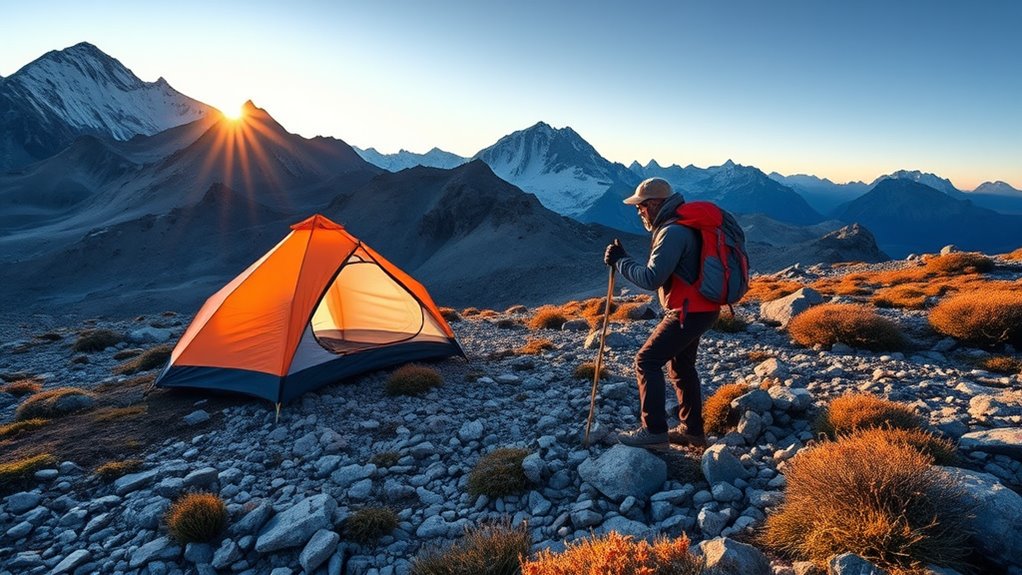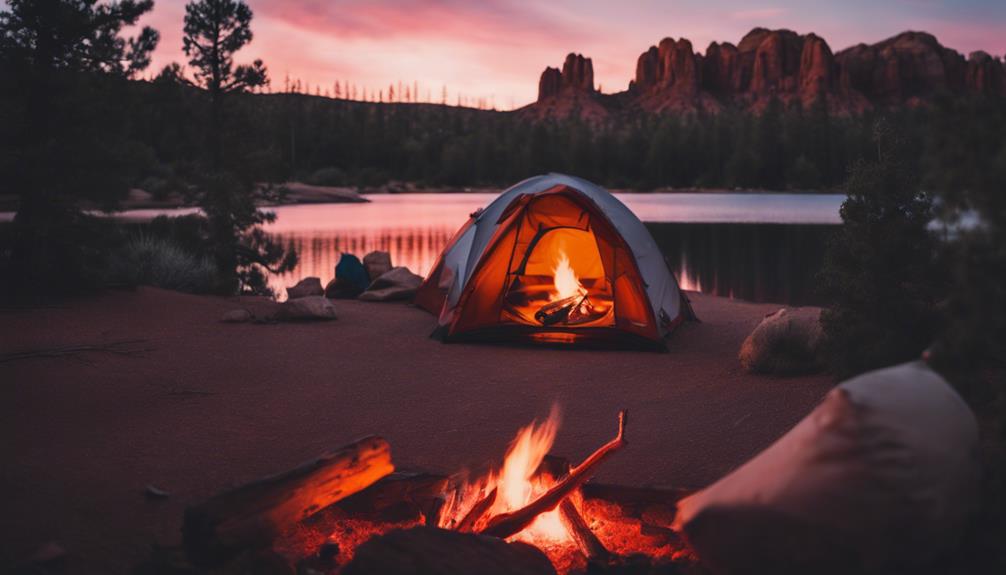When setting up camp at high altitude, prioritize safety by selecting sheltered, hazard-free sites away from avalanche zones and strong winds. Use reliable gear, including an altimeter and high-quality sleeping bags, to support acclimatization. Stay hydrated and monitor for symptoms of altitude sickness like headaches or dizziness. Rest and avoid overexertion to aid your body’s adjustment. Proper site selection and health management are vital—continue to explore these expert strategies for safer, more effective high-altitude camping.
Key Takeaways
- Select a sheltered, stable site that minimizes exposure to wind, sun, and environmental hazards for safer acclimatization.
- Ensure reliable altitude monitoring and carry proper gear, including cold-rated sleeping bags and ventilation tents.
- Maintain adequate hydration with regular water intake and use filtration systems to prevent dehydration-related altitude sickness.
- Prioritize rest and gentle activities; elevate the head during sleep to aid recovery and adaptation.
- Vigilantly monitor for symptoms of altitude sickness and descend immediately if severe symptoms develop.

Setting up camp at high altitude demands careful preparation and attention to detail. Your primary concern should be preventing altitude sickness, which can develop rapidly as your body adjusts to lower oxygen levels. To do this effectively, you need to be equipped with the right equipment essentials. Ensure your gear includes a reliable altimeter or GPS device to monitor your elevation accurately. This helps you stay within safe altitude limits and plan your acclimatization schedule accordingly. Lightweight, high-quality sleeping bags rated for cold temperatures are also vital, as high-altitude environments are typically frigid, and poor insulation can exacerbate altitude-related issues. A sturdy, multi-layer tent with good ventilation is non-negotiable; it protects you from harsh weather and helps regulate humidity and temperature inside, promoting better sleep and recovery.
Ensure reliable gear like altimeters, cold-rated sleeping bags, and ventilated tents for safe high-altitude camping.
Your equipment essentials should further include a well-stocked first aid kit, with medications specifically aimed at altitude sickness, such as acetazolamide (Diamox), and other necessary supplies like dehydration solutions and pain relievers. Hydration is critical at high altitude, so carry ample water and a portable filtration system to ensure you can access clean drinking water. Remember, dehydration heightens the risk of altitude sickness and impairs your body’s ability to acclimate, so never underestimate the importance of consistent fluid intake. Additionally, understanding the physiological effects of high altitude can help you better recognize early symptoms and respond appropriately.
When setting up your camp, choose a site that minimizes exposure to wind, direct sunlight, and potential avalanche or rockfall hazards. This reduces physical stress and environmental strain, aiding your body’s adjustment process. Once established, prioritize resting and acclimatization over strenuous activity. Sleep is vital, and your equipment essentials should support a comfortable sleeping environment to facilitate recovery and acclimatization. Keep your head elevated and maintain a steady intake of fluids and carbohydrates to help your body adapt.
Monitoring your symptoms diligently is crucial. Be alert for signs of altitude sickness such as headaches, nausea, dizziness, or fatigue. If symptoms worsen, do not attempt to press onward. Instead, descend to a lower elevation immediately and seek medical help if necessary. Your safety depends on your awareness and preparedness. In sum, setting up camp at high altitude requires meticulous planning, proper equipment, and a disciplined approach to acclimatization. With the right gear and vigilance, you can minimize risks and enjoy the profound experience of high-altitude camping safely and comfortably.
Frequently Asked Questions
How Do I Recognize Early Signs of Altitude Sickness?
You can recognize early altitude sickness signs through altitude symptoms like headaches, dizziness, nausea, and fatigue. Pay close attention to your health monitoring by noting any difficulty sleeping or shortness of breath. If these symptoms worsen or persist, descend immediately. Staying vigilant and acting promptly guarantees your safety, as early detection of altitude sickness allows for effective management and prevents severe complications. Trust your body’s signals and prioritize safety at high elevations.
What Are the Best Foods to Eat at High Altitude?
Think of your body as a high-performance machine needing fuel. You should prioritize nutrient-dense foods like nuts, lean meats, and whole grains, which provide essential energy and support altitude adaptation. Stay hydrated with regular water intake and electrolyte drinks to combat dehydration. These strategies optimize oxygen use, reduce fatigue, and promote acclimatization, ensuring you maintain strength and alertness in the thin mountain air.
How Can I Prevent Cold-Related Injuries During High-Altitude Camping?
To prevent cold-related injuries, you should implement effective layering strategies, adding or removing clothing as needed to stay warm without overheating. Always carry emergency preparedness gear like thermal blankets, hand warmers, and a reliable heat source. Stay dry, keep extremities covered, and monitor your body’s responses. Prioritize early recognition of symptoms and respond swiftly to maintain core warmth, ensuring safety during high-altitude camping.
What Gear Is Essential for High-Altitude Sleep Comfort?
Guarantee your sleeping gear provides ideal temperature regulation for high-altitude comfort. Use a high-quality, insulated sleeping bag rated for extreme cold, complemented by a sleeping pad for insulation from the ground. Add a thermal liner if necessary. Choose a tent with good ventilation and weather resistance. Don’t forget a warm hat and layered clothing to keep your head and body warm. Proper gear assures restful sleep and essential recovery at altitude.
How Should I Plan My Acclimatization Schedule?
Think of acclimatization like a slow dance—you need to move gradually to avoid stumbling. Start with low-altitude training, then ascend slowly, increasing elevation by no more than 300-500 meters daily. Prioritize hydration strategies, drinking consistently to combat altitude sickness. Listen to your body; if you feel symptoms, descend. This cautious approach guarantees your body adapts smoothly, reducing risks and boosting your high-altitude performance.
Conclusion
While it might seem tempting to push on and ignore your body’s signals, remember that rushing at high altitude often leads to setbacks. Ironically, taking the time to properly acclimate and prioritize safety guarantees you’ll actually enjoy the summit, not just survive the climb. Trust experienced guides and listen to your body—it’s the most reliable GPS you’ll have. After all, the mountain doesn’t rush, so neither should you. Proper preparation turns lofty ambitions into triumphant realities.









